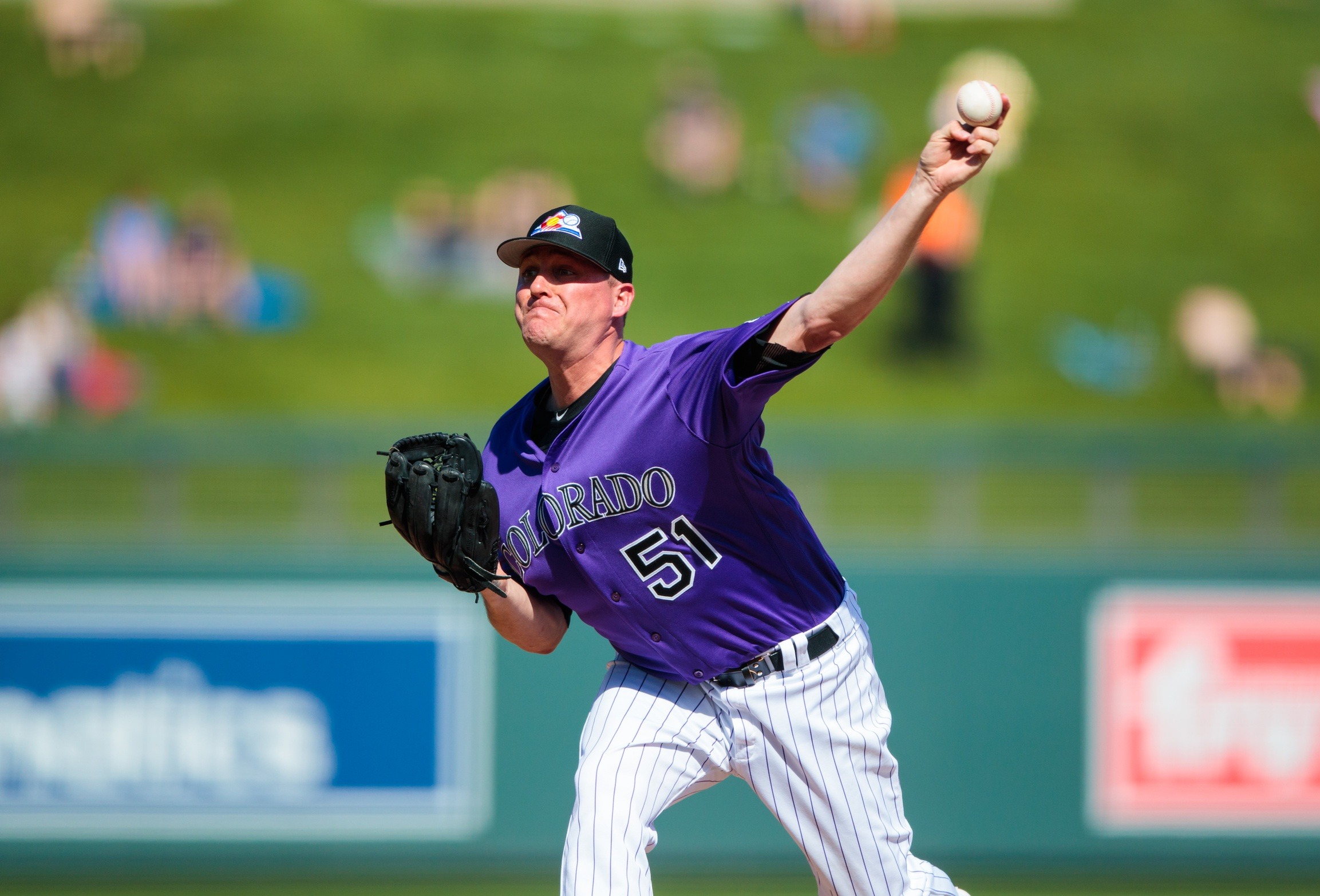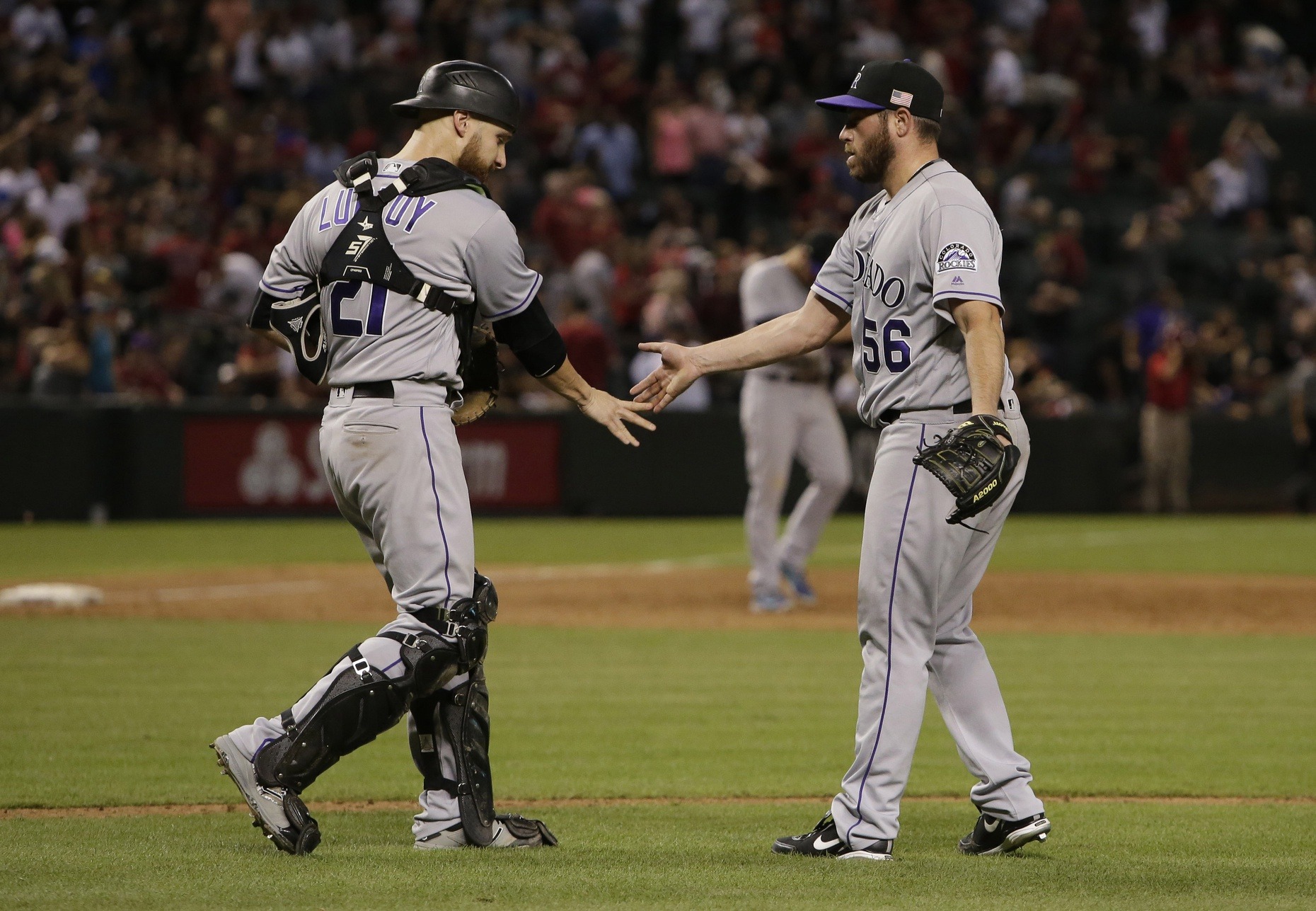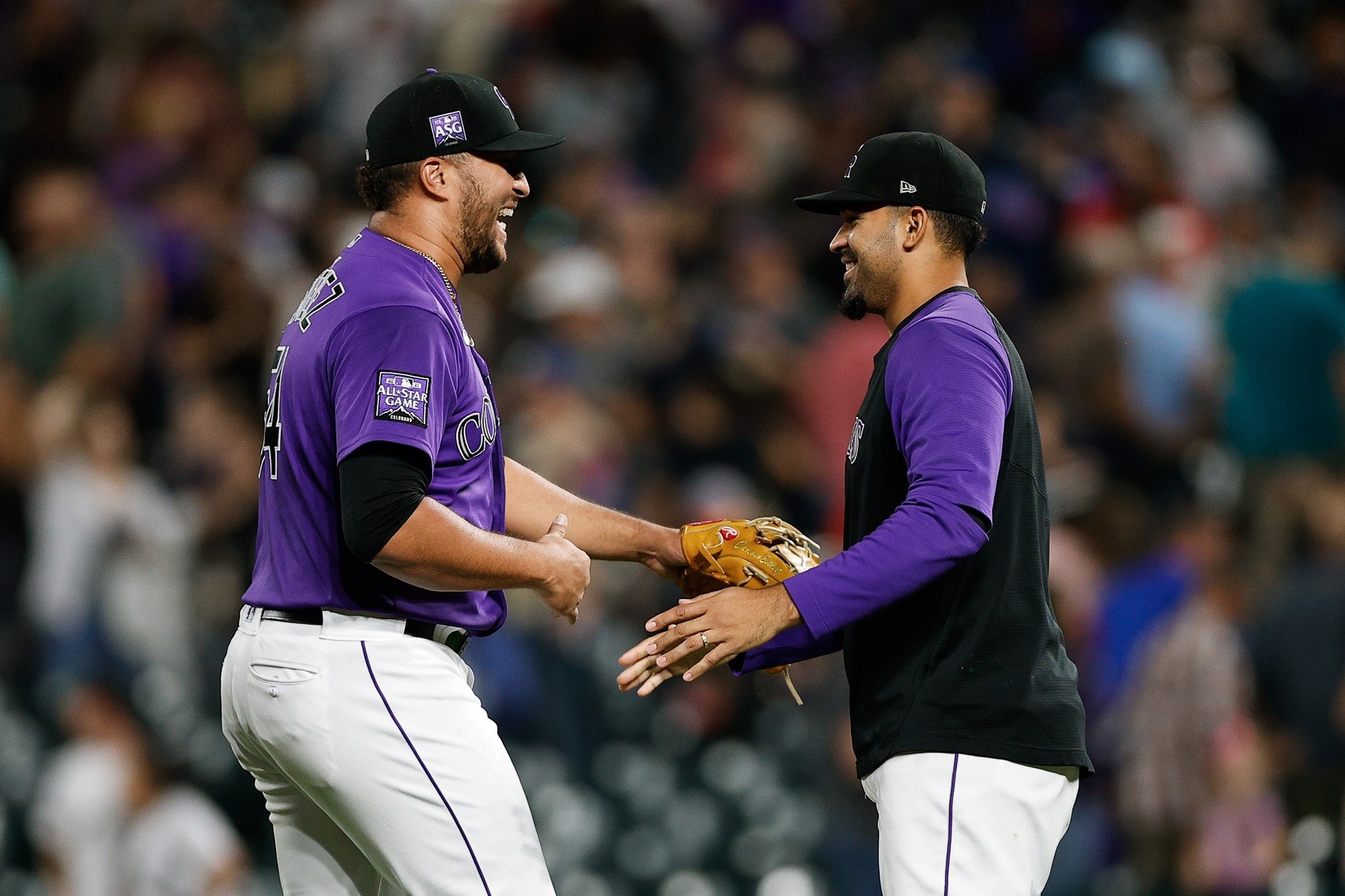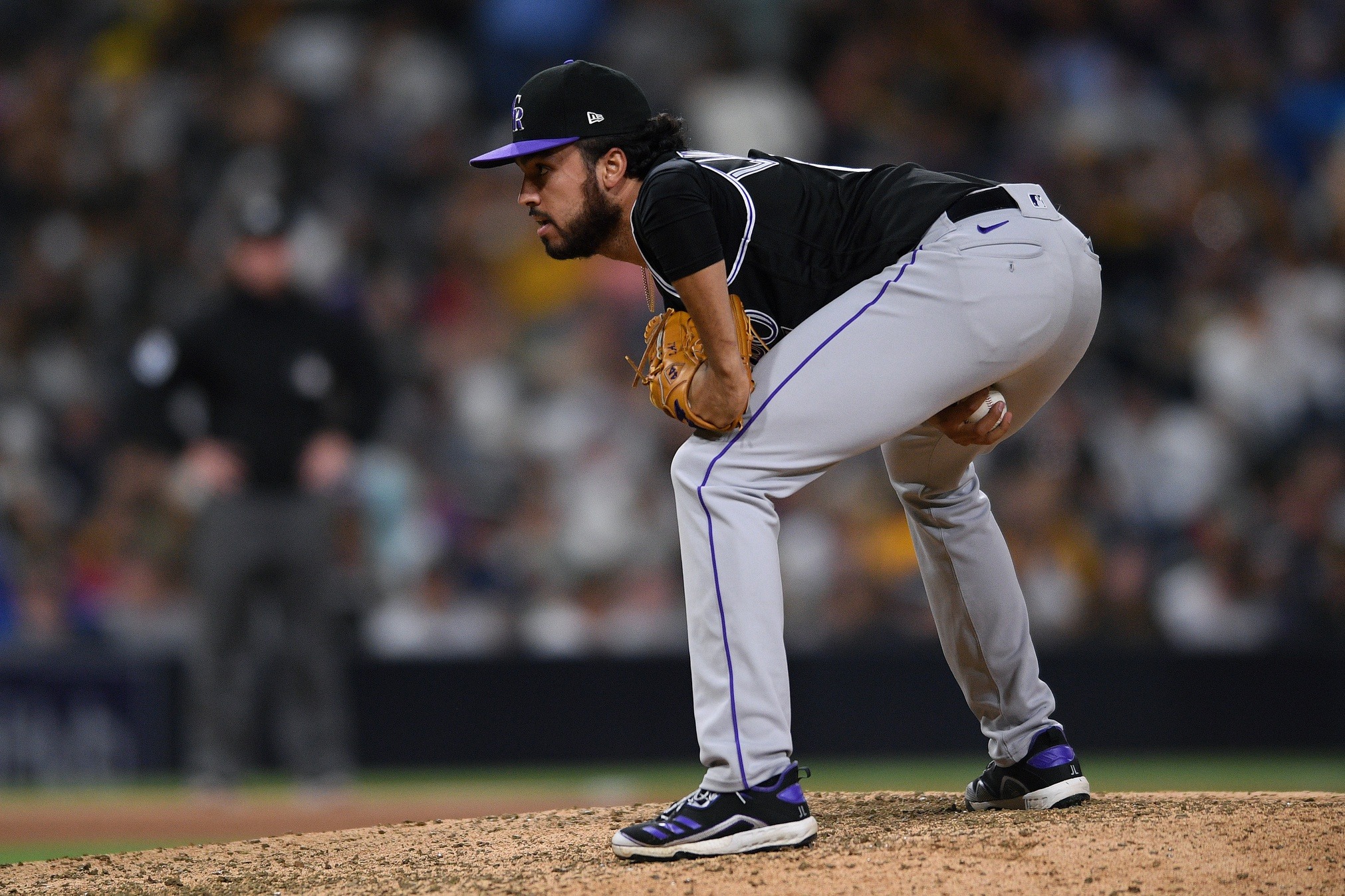© 2025 ALLCITY Network Inc.
All rights reserved.

How much difference can one year make?
If you’ve been watching the Colorado Rockies lately, you’ve probably noticed that they’ve been a much better ballclub since the end of May. If you’ve been watching closely, you’ve definitely still noticed that several of their fundamental flaws remains the same, though.
The offense is unreliable, especially on the road where the whole team is a shell of itself, and, though they’ve been a bit better lately, the bullpen is a mess.
Also, if you’ve been listening to what the club has been saying, you know they intend to try to compete next season, using just one winter’s worth of transactions to take this substandard team and turn them into a postseason one.
Seems like a long shot, right?
Well, it definitely is, but even recent Rockies history shows us that it is nowhere near an impossibility.
Not so long ago in a time called “2016” the Colorado baseball club featured a truly terrible bullpen and slogged to a mediocre season. Sound familiar?
According to the league and park-adjusted ERA+, they had just three qualified relievers who were better than the league average mark of 100.
The newly-acquired Jake McGee struggled through an injury-riddled campaign but did muster a 103, though his raw ERA of 4.77 and his six years in Tampa being an elite reliever dampened any notion that he had a “good” season.

Boone Logan, who had also been a major let-down to that point considering his resume pre-Colorado, was actually the team’s best arm out of the ‘pen that year, posting an ERA of 3.69 and an ERA+ of 132 over 46.1 innings pitched. Solid, but nowhere near elite and not in a late-inning role.
Chris Rusin, who made seven starts that season and even threw a complete game shutout at Coors Field the year prior, was converted to relief where he faired nicely, putting up an ERA of 3.74 and an ERA+ of 130 over 84.1 innings pitched total. Honestly, more impressive than Boone given the workload.
Only Adam Ottavino, who returned at the end of the season after recovering from Tommy John surgery, put up numbers that you might be able to consider elite but his 2.67 ERA (184 ERA+) came in just 27 mostly-meaningless innings.
That reliever core struggled so much, in fact, that a rookie Carlos Estevez was forced into the closer role less than a month after his call up and less than a full year since he was pitching in High-A ball.
He started out well and collected 11 saves but fell off hard and ended the season with a 93 ERA+. This for a team that was playing .500 baseball.
Veterans Chad Qualls and Jason Motte were meanwhile highly disappointing for their entire tenures in Colorado, cheaper versions of mistakes that were yet to come.
The rest of the efforts in the bullpen that season came either from “oh yeah I remember him… kinda” guys or converted starters who they simply hoped could figure it out.
Gonzalez German, Justin Miller, Christian Bergman, Jeff Hoffman and lot of innings from Jordan Lyles and Eddie Butler rounded out one of the worst ‘pens in franchise history.
They collectively put up a 5.13 ERA, the worst mark in MLB.
Thanks to a couple of standouts they were able to put up a positive fWAR at 1.8 which placed them 23rd in baseball.
All of the shuffling around was clearly a sign that they were in search of answers that didn’t arrive… until next season.
In 2017, the Colorado Rockies bullpen posted an ERA of 4.40, not exactly eye-popping but a rise from 30th to 20th just in raw ERA despite Coors Field.
When you adjust for the ballpark and the heavy innings load, the Rox ’17 relievers posted an fWAR of 6.5, the fifth best mark in MLB and the second best in the National League just behind the Los Angeles Dodgers at 6.7.
How did they do this?
Did they bring in a slew of free agent relievers with incredible resumes or graduate a ton of promising arms from there farm system? Well… not really?

Make no mistake, Greg Holland was a massive addition to the team but he was also picked up for non-closer money after having not pitched in over a year and was signed to an incentive-heavy contract.
His $6 million base salary ended up becoming $13 million. That was because he more than earned it as an All-Star, two-time Reliever of the Month, and by leading the National League in Saves with 41. His ERA+ of 140 was eight points better than any Rockies reliever the year prior.
Jake McGee joined him with a 140 ERA+ in a bounce back from injury and his best work in purple. He was one of the better set-up men in baseball that year and even served nicely as a spot closer whenever Holland needed a rest.
Rusin went from a nice, fun story to one of the best relievers in the game, pitching 85 innings to a 191 ERA+ absolutely dwarfing any such numbers the club had seen in years.
Mike Dunn was also a really solid free agent to bring in, at least for the first year of his three-year deal. He was by no means a superstar nor was he that expensive with an AAV of $6.3 million. But his 113 ERA+ as a lefty picking up over 50 innings was vital to that team’s improvement.
Oddly enough, Ottavino was the one guy who seemed most likely to break out in 2017 but after a promising start he completely lost his command, famously blowing games without even allowing hits at times. Still, he managed an ERA+ of 100.
Scott Oberg, who barely appeared the year before making his MLB debut to little fanfare, took a substantial but not huge step forward, putting up a 103 ERA+ in 54.1 innings.
Due to a suddenly super consistent rotation filled with young players not quite ready for full-time workloads, starters Tyler Chatwood, Chad Bettis, Kyle Freeland, and Antonio Senzatela also all worked out of the ‘pen that year to above average results.
And then at the trade deadline, the Rockies went out and landed Pat Neshek who put up a whopping 208 ERA+ over his 22 innings in purple pinstripes.
Estevez had easily the most disappointing season of any reliever… right up until he didn’t.

His 91 ERA+ from that year belies the fact that after he made a mechanical change in his delivery, he dominated down the stretch. He became Bud Black’s go-to pitcher against power righties and made the postseason roster over Ottavino because he was pitching so well. He even appeared in the Wild Card game.
And that was their worst reliever that year.
(Well, other than Jordan Lyles who played himself right off the team with an ERA+ of 73.)
If you’re counting along at home, that’s now eight relievers with an ERA+ of 100 or better and a ninth who dominated during the most important games. And that’s before you even get to the contributions of the starters.
Remember, in 2016 they had only three such pitchers at 100 or better. And one of those was McGee’s 103.
Holland and Dunn were the only new guys.
Not counting the starters, there also weren’t any call-ups from the minors that added value to the ‘pen either.
McGee, Rusin, Estevez, Ottavino, Oberg, Chatwood, and Bettis were all on the MLB roster already.
The 2016 Colorado Rockies put up a team ERA+ of 99. The 2017 Colorado Rockies put up a team ERA+ of 112, tied for the best in franchise history.
There are a lot of lessons to be learned here.
The first is what not to do next.
That offseason, they handed lucrative deals to veteran relievers in Wade Davis and Bryan Shaw, and another one in order to keep McGee coming off his great year.
As all Rockies fans know, despite Davis actually setting the franchise record for Saves in 2018, all three deals would blow up in their faces and hamstring their ability to be flexible with their roster over the next three years.
That team actually still had a strong bullpen, and a team ERA+ of 109, but it was all downhill after that.
So, looking forward, there’s no need to hand out these bigger, long-term deals to relievers even though it’s obvious that this is a giant area of need.
The Rockies should be looking to replicate the Holland deal as much as possible and even the Dunn deal (ha) that was much easier to get out from underneath once his health proved to be an issue.
So, in looking forward to 2022, Colorado should be targeting only a couple of veteran relievers looking to prove themselves who they can sign to contracts that don’t tie either party together too deeply or for too long.
They also need to leave space to see if Justin Lawrence or Julian Fernandez or Ben Bowden or Lucas Gilbreath can be the next Chris Rusin. Believe me when I tell you that nobody thought Chris Rusin was going to be what he was those years in Denver.

They need to see what they’ve got in Robert Stephenson and Jordan Sheffield as much as they can down the stretch. They’ve got Oberg-level development potential.
They need to keep giving chances to guys like Yency Almonte (yes, I know) for any possible glimpse of a comeback. They need to take a long-hard look at what Jhoulys Chacin truly has left because he has been exactly the kind of reclamation they need moving forward.
Daniel Bard is another great example of what to do, both in how he was great in 2020 and how he has struggled in 2021.
Bard was acquired, much like Holland, on the cheap after a long absence and was given an opportunity. For a while, it really worked out. He, again like Holland, earned the closer gig quickly and dominated.
And while he has had some great outings in 2021, he has had some truly terrible ones, especially as of late. But because the Rockies are nowhere near as invested in him as they were Davis, it was a much easier decision to move him down the depth chart in search of answers elsewhere. Now Estevez is now picking up closing duties for the first time in five years.
This kind of flexibility is extremely important for a team that has to be able to catch lightning in a bottle in the bullpen whenever they can.
However, this does not mean that the Rockies should stand pat and just hope guys get better in order to compete. You still have to go out and scout and sign the Hollands, and Rusins and Bards of the world.
Somebody has to find a way to get the final three outs for this team.
You’ve also got to leave open the possibility of converting starters, something that has benefitted them in the short term before.
With this current rotation set and strong when healthy, finding the best place for young arms like Peter Lambert and Ryan Rolison is also going to be a factor here.
There is no one secret formula to building a bullpen. Or, at least if there is, nobody has figured it out yet. Bullpens remain one of the most difficult to predict things in all of sports from year to year.
But history is often life’s greatest teacher and you don’t have to go searching far back in time to find a moment when Colorado went from having one of the worst bullpens in the league (and in their history) to one of the best.
They did it in one offseason by adding two players almost nobody was over-the-moon excited for.
Right now, Colorado has only three relievers with an ERA+ of 100 or better. Could that number jump to eight next year?
If you make a few smart moves, develop a couple of young guys, and, yes, get a little bit of luck… it’s not so far-fetched after all.
Comments
Share your thoughts
Join the conversation



